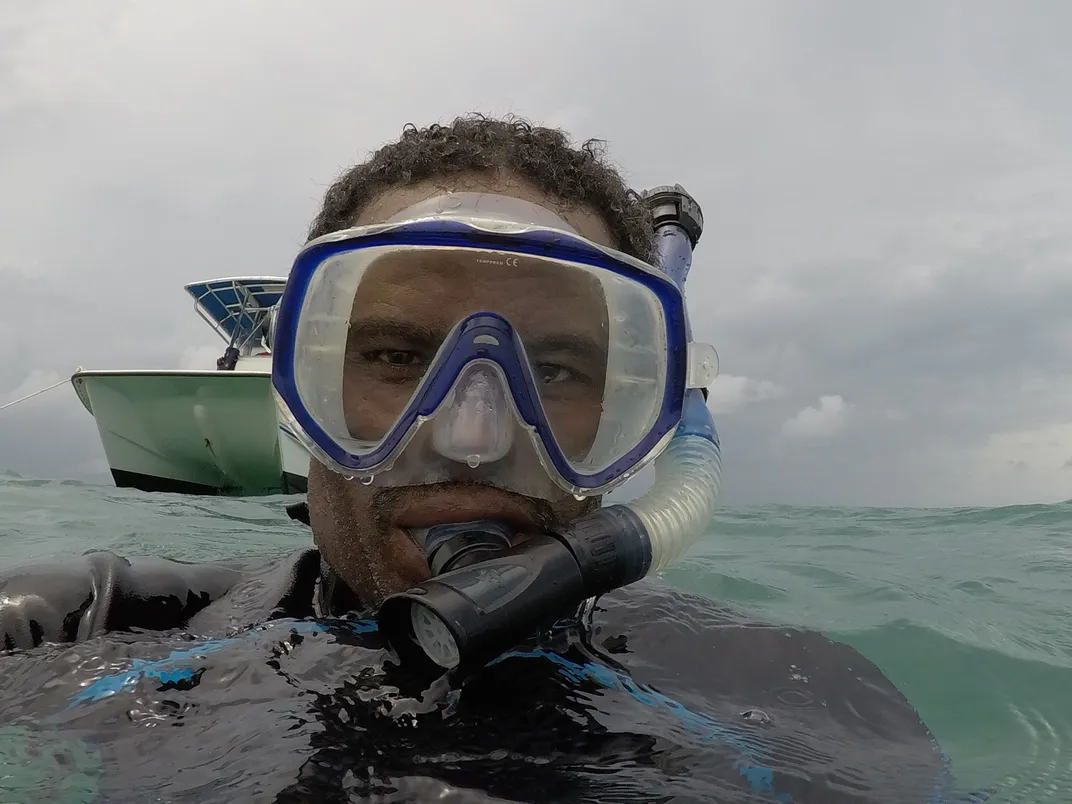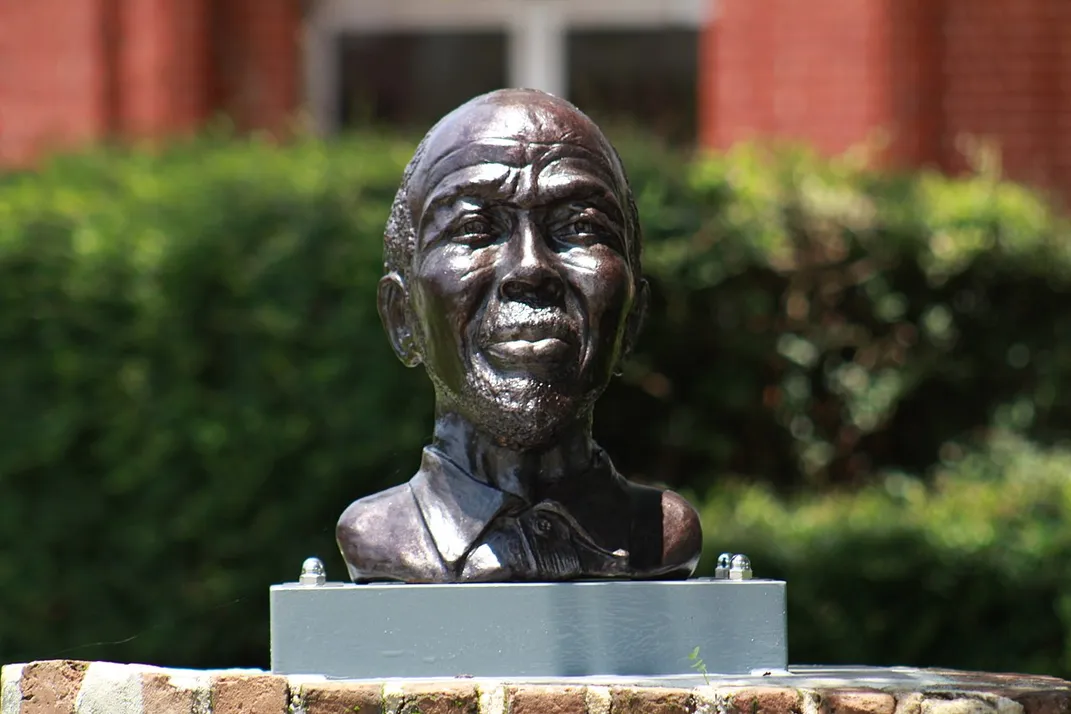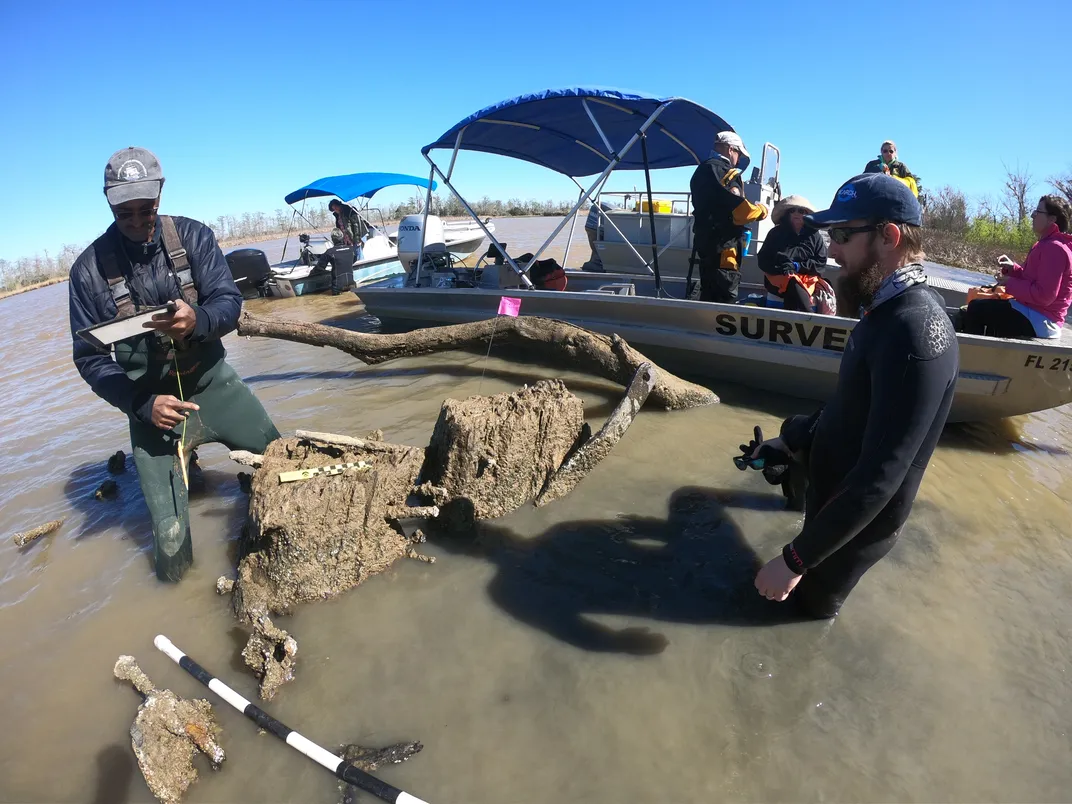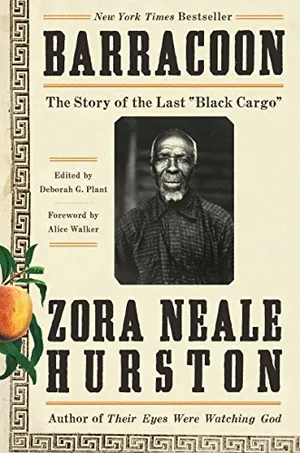The ‘Clotilda,’ the Last Known Slave Ship to Arrive in the U.S., Is Found
The discovery carries intense personal meaning for an Alabama community of descendants of the ship’s survivors
:focal(257x247:258x248)/https://tf-cmsv2-smithsonianmag-media.s3.amazonaws.com/filer/66/f8/66f82a81-ebad-405e-8c6e-99aba83c4d0f/cudjoe_abache.jpg)
One hundred and fifty-nine years ago, slave traders stole Lorna Gail Woods’ great-great grandfather from what is now Benin in West Africa. Her ancestor, Charlie Lewis, was brutally ripped from his homeland, along with 109 other Africans, and brought to Alabama on the Clotilda, the last known slave ship to arrive in the United States. Today, researchers confirmed that the remains of that vessel, long rumored to exist but elusive for decades, have been found along the Mobile River, near 12 Mile Island and just north of the Mobile Bay delta.
“The excitement and joy is overwhelming,” says Woods, in a voice trembling with emotion. She is 70 years old now. But she’s been hearing stories about her family history and the ship that tore them from their homeland since she was a child in Africatown, a small community just north of Mobile founded by the Clotilda’s survivors after the Civil War.
The authentication and confirmation of the Clotilda was led by the Alabama Historical Commission and SEARCH Inc., a group of maritime archaeologists and divers who specialize in historic shipwrecks. Last year, the Smithsonian’s National Museum of African American History and Culture’s Slave Wrecks Project (SWP) joined the effort to help involve the community of Africatown in the preservation of the history, explains Smithsonian curator and SWP co-director Paul Gardullo.
Two years ago, Gardullo says talks began about mounting a search for the Clotilda based on conversations with the descendants of the founders of Africatown. Then last year, it seemed that Ben Raines, a reporter with AL.com had found the Clotilda, but that wreck turned out to be too large to be the missing ship. Gardullo says everyone involved got moving on several fronts to deal with a complicated archaeological search process to find the real Clotilda.
“This was a search not only for a ship. This was a search to find our history and this was a search for identity, and this was a search for justice,” Gardullo explains. “This is a way of restoring truth to a story that is too often papered over. Africatown is a community that is economically blighted and there are reasons for that. Justice can involve recognition. Justice can involve things like hard, truthful talk about repair and reconciliation.”
/https://tf-cmsv2-smithsonianmag-media.s3.amazonaws.com/filer/7f/7c/7f7ca814-58b5-4bb7-acd2-0d97560cc498/welcome_to_africatown_cropped.jpg)
Even though the U.S. banned the importation of the enslaved from Africa in 1808, the high demand for slave labor from the booming cotton trade encouraged Alabama plantation owners like Timothy Meaher to risk illegal slave runs to Africa. Meaher took that risk on a bet that he could bring a shipload of Africans back across the ocean. In 1860, his schooner sailed from Mobile to what was then the Kingdom of Dahomey under Captain William Foster. He bought Africans captured by warring tribes back to Alabama, skulking into Mobile Bay under the cover of night, then up the Mobile River. Some of the transported enslaved were divided between Foster and the Meahers, and others were sold. Foster then ordered the Clotilda taken upstream, burned and sunk to conceal the evidence of their illegal activity.
After being freed by Union soldiers in 1865, the Clotilda’s survivors sought to return to Africa, but they didn’t have enough money. They pooled wages they earned from selling vegetables and working in fields and mills to purchase land from the Meaher family. Calling their new settlement Africatown, they formed a society rooted in their beloved homeland, complete with a chief, a system of laws, churches and a school. Woods is among the descendants who still live there. Finally, she says, the stories of their ancestors were proved true and now have been vindicated.
“So many people along the way didn’t think that happened because we didn’t have proof. By this ship being found we have the proof that we need to say this is the ship that they were on and their spirits are in this ship,” Woods says proudly. “No matter what you take away from us now, this is proof for the people who lived and died and didn’t know it would ever be found.”
The museum’s founding director, Lonnie Bunch, says the discovery of The Clotilda tells a unique story about how pervasive the slave trade was even into the dawn of the Civil War.
“One of the things that’s so powerful about this is by showing that the slave trade went later than most people think, it talks about how central slavery was to America’s economic growth and also to America’s identity,” Bunch says. “For me, this is a positive because it puts a human face on one of the most important aspects of African American and American history. The fact that you have those descendants in that town who can tell stories and share memories – suddenly it is real.”
Curators and researchers have been in conversation with the descendants of the Clotilda survivors to make sure that the scientific authentication of the ship also involved community engagement.
Smithsonian curator Mary Elliott spent time in Africatown visiting with churches and young members of the community and says the legacy of slavery and racism has made a tangible footprint here in this place across a bridge from downtown Mobile. In a neighborhood called Lewis Quarters, Elliott says what used to be a spacious residential neighborhood near a creek is now comprised of a few isolated homes encroached upon by a highway and various industries.

“What’s powerful about Africatown is the history. What’s powerful about it is the culture. What’s powerful about it is the heritage stewardship, that so many people have held onto this history, and tried to maintain it within the landscape as best they could,” Elliott says. “But it also shows the legacies of slavery. You see environmental racism. You see where there’s blight and not necessarily because the residents didn’t care; but due to a lack of resources, which is often the case for historic black communities across the country. When people drive through that landscape, they should have a better sense of the power of place, how to read the land and connect to the history.”
But Elliott sees a beauty here as well, through the lens of the original Clotilda survivors.
“You can close your eyes and think of when these enslaved African men, women and children came into this site,” Elliott says of the men and women, who bought their land, but still had to survive in a segregated, racist environment. “It comes down to having a vision not just for that moment, but for generations to come. For them to create that community is very significant because there is empowerment, not just in having land but having that kinship network of community members connected by way of being on that ship.”
The significance of the find was also on the minds of SWP members involved in the search for the schooner, like diver Kamau Sadiki, an archaeology advocate and instructor with Diving with a Purpose.
There are no photographs of the site where the Clotilda was found or of the wreck itself. “[The ship] wasn’t very deep. Eight to ten feet at most,” Sadiki recalls. “But the conditions are sort of treacherous. Visibility was almost zero and there’s some current, but the most important thing is that you’re among wreckage that you cannot see. There’s a whole host of possibilities to being injured, from being impaled, to getting snagged and so forth.”

Sadiki was also part of the dive team that worked the South African site of the slave ship São José Paquete de Africa, one of the first historically documented ships carrying enslaved Africans when it sank. Artifacts from the ship, including iron ballast, a wooden pulley and slave shackles, are on display at the National Museum of African American History and Culture. Sadiki says touching that vessel made him “hear the screams and the horrors and the suffering” of those aboard. But working with the Africatown community and the Clotilda search was intimate for him on a different level.
“I knew what that ship represents, the story and the pain of the descendant community. I’ve heard the voices; I can look them in the eye and see the pain of the whole Africatown experience over the past hundred plus years,” Sadiki explains. “They have been very resilient. The Clotilda should be known by everyone who calls themselves an American because it is so pivotal to the American story.”
Bunch says this feels powerful and emotional to him in a similar way to when he was able to lay his hands upon the iron ballast from the São José, which brought him to tears.
“What’s different about this is that when we did the São José, a part of it is because there were human remains there, and that was really a way to honor those folks. With the Clotilda, we honor not the remains, but the survival of the people who created Africatown,” he says.
Gardullo adds that the story of the Clotilda has layers that are deeply rooted in the present as well as the past. “There’s real concern about whether somebody is going to take action here in a negative way to go and do damage to this invaluable cultural resource,” Gardullo says, adding that history is never in the past. “This history of slavery is always with us. Even things that seem ancient and seem like they’re remnants of the past are continuing to shape our present and we have to deal with that in very practical ways and sometimes that involves real protection.”

Elliott says there are ongoing discussions about the kinds of programs and exhibitions that might occur, to commemorate and remember this American story. The question is what do those look like and how do they draw the larger community to a history that is local, national and global in scope. She explained that one possibility is a "big read" program, where community residents collectively read and reflect upon Zora Neale Hurston’s book Barracoon. The book is based on Hurston’s 1927 interviews with Cudjo Lewis, brother of Charlie Lewis and one of the last survivors of the Clotilda. In his own dialect, Cudjo Lewis tells the story of his capture, his journey to the U.S., and the beginning of Africatown.
We call our village Affican Town. We say dat ‘cause we want to go back in de Affica soil and we see we cain go. Derefo’ we makee de Affica where dey fetch us.
Plans are also in the works for a National Park Service Blueway here, rather like a water-based heritage trail. The Smithsonian’s Gardullo adds that the team is also considering just how to preserve the Clotilda, and where it could best be saved for the long term so that it can reach the most people. It also inspires bigger, more philosophical questions.
Barracoon: The Story of the Last "Black Cargo"
In 1927, Zora Neale Hurston went to Plateau, Alabama, just outside Mobile, to interview 86-year-old Cudjo Lewis. Of the millions of men, women and children transported from Africa to America as slaves, Cudjo was then the only person alive to tell the story of this integral part of the nation’s history. Hurston was there to record Cudjo’s firsthand account of the raid that led to his capture and bondage 50 years after the Atlantic slave trade was outlawed in the United States.
“What can this actually teach us? What can this teach us about ourselves? How can the history of this ship drenched in oppression liberate us,” Gardullo wonders. “People from Africatown itself have to help us begin to think about what’s important here.”
Africatown native Anderson Flen hopes it brings his birthplace the attention it needs in terms of equity for a community he feels has been deliberately decimated. He says he doesn’t know if he is related directly to the Clotilda survivors, partly because of the way African-Americans who came from the motherland were split apart.
“There’s been a lack of thoroughness as it relates to African-American history because of what happened to them, and so our history is really one that is a mystery to many of us, and therefore there’s a void and pain,” Flen says, adding that he hopes this discovery brings enough attention to Africatown to change things for residents.
But Lorna Gail Woods says she is more than glad that the Clotilda has finally been found because it is a tribute to the strength of her ancestors.
“We should be proud of the land they almost starved to death trying to buy, probably so they could leave a legacy for us,” Wood says. “And now we’re able to tell their part of the story, and that’s the joy I get from knowing the Clotilda was not just a myth. It was a living thing that happened.”
A Note to our Readers
Smithsonian magazine participates in affiliate link advertising programs. If you purchase an item through these links, we receive a commission.
/https://tf-cmsv2-smithsonianmag-media.s3.amazonaws.com/accounts/headshot/allison.png)

/https://tf-cmsv2-smithsonianmag-media.s3.amazonaws.com/accounts/headshot/allison.png)